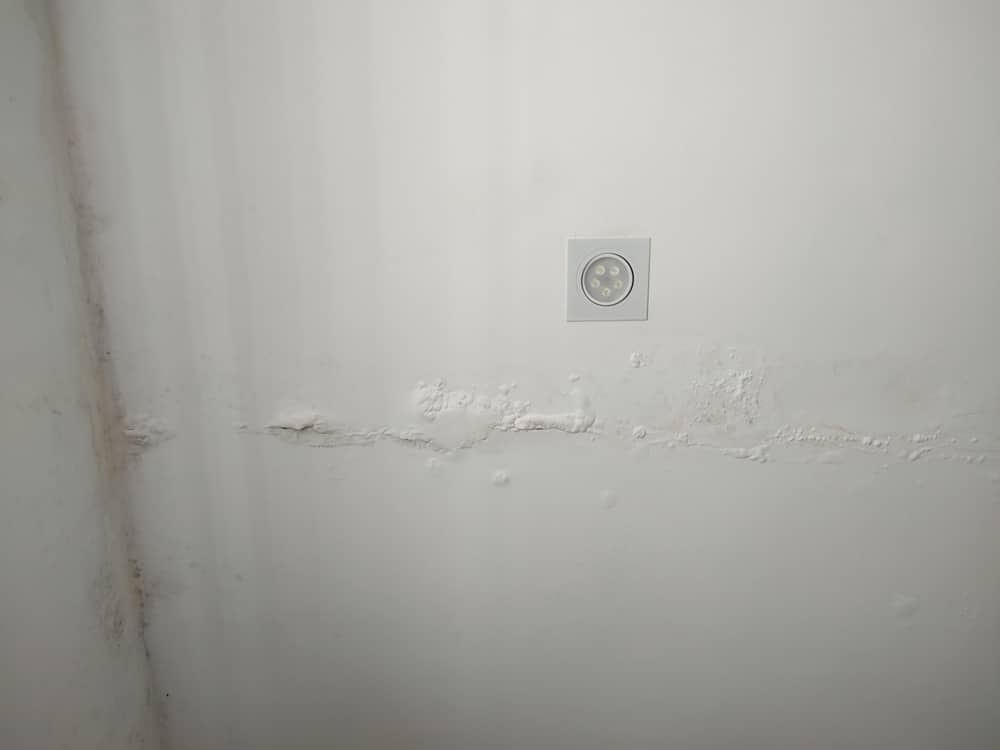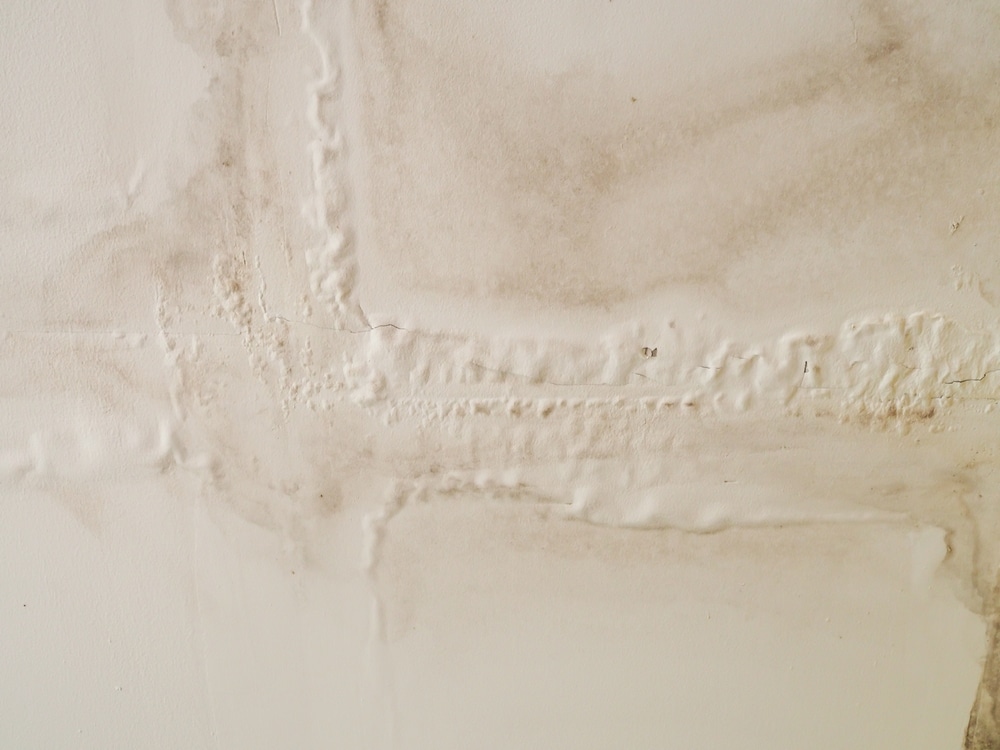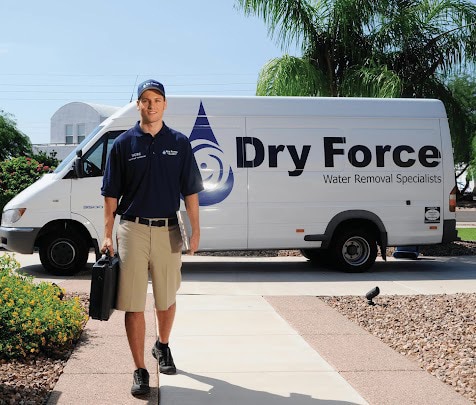
Have you noticed a strange bulge in your wall or patches of bubbling paint? You might be looking at a water bubble in the wall. This is a common but potentially serious home issue. These bubbles form when moisture gets trapped beneath the surface, pushing paint, plaster, or drywall outward.
In Texas, where humidity, heavy rain, and plumbing leaks are everyday challenges, wall bubbles can often appear. Left untreated, they can lead to mold growth, structural damage, and costly repairs.
The good news? With the right approach, you can fix water damage in your walls and prevent it from coming back. At Dry Force, we’ve seen it all, from small bathroom paint blisters to whole-wall moisture damage.
Here’s what you need to know to protect your home.
Table of Contents
Why Water Bubbles in Walls Are a Serious Problem
Water bubbles in walls may look minor at first, but they’re often a warning sign of a much bigger problem. They develop when moisture seeps in and gets trapped beneath the paint or wall surface. This can be caused by an internal (plumbing, leaks, high humidity) or external (roof leaks, heavy rain) water source.
As vapor pressure builds, the wall covering begins to lift and bulge, creating the visible bubble. While the blemish itself might seem harmless, the moisture behind it is not. Left unaddressed, it can spread and cause serious wall moisture damage.
Water bubbles also create the perfect conditions for mold and mildew to grow. Acting quickly can mean the difference between a simple surface repair and an expensive, large-scale restoration.
Common Causes of Water Bubbles in Walls
Water bubbles can develop for several reasons, and pinpointing the root cause is essential for lasting repairs.
While it’s tempting to simply scrape, patch, and paint over the damage, the bubble will almost always return if the underlying issue isn’t fixed.
Understanding how and why water is getting in will help you choose the right repair approach and prevent future damage.
Here are common causes of bubbling paint on walls:
- Roof Leaks: Rainwater can enter through damaged shingles or flashing and travel down into the walls.
- Plumbing Leaks: Burst pipes, loose fittings, or slow leaks behind walls can cause hidden moisture buildup.
- Condensation & High Humidity: Bathrooms, laundry rooms, and kitchens without proper ventilation are susceptible to moisture build-up.
- Poor Surface Preparation Before Painting: Painting over damp walls or skipping primer allows moisture to disrupt adhesion.
- Cracks in Exterior Walls or Siding: Gaps in walls or siding let rainwater seep in and saturate interior surfaces.

Warning Signs of Water Bubbles in Walls
The sooner you spot a water bubble in the wall, the easier it is to fix and stop further damage. Excess moisture is the leading cause of wall bubbling, and it can result from a variety of issues.
Look out for these warning signs:
Visible Paint Bubbling or Blistering
One of the most apparent signs is paint lifting away from the wall surface. If the paint looks lifted or swollen, you likely have excess moisture coming into your home.
Stains or Discoloration Around the Bubble
Brown, yellow, or dark patches near the affected area often mean that water damage in the walls has spread. Left untreated, it can seriously threaten the structural integrity of your home.
Soft or Spongy Wall Texture
If the wall feels soft to the touch, you likely have drywall damage underneath. Such damage allows increased moisture to collect, which creates the bubbling effect.
Musty Odor Near Affected Area
Look out for a damp, earthy smell near the wall bubble. This may signal hidden mold that requires immediate removal and remediation to prevent health risks.
Spread or Enlargement Over Time
If you notice the bubble in the wall grow over time, this means that the moisture source is still active. Immediate inspection and removal of the water source is the best next step.
If you notice any of these warning signs, contact Dry Force’s expert water damage technicians right away. We’ll help identify the source and prevent further moisture harm to your home.
Prevention & Maintenance Tips
Stopping wall bubbles in walls before they start is always better than repairing them later. Keep these prevention and maintenance tips in mind to keep your home in good condition:
- Inspect regularly: Check walls and ceilings for bubbling or discoloration, especially after storms.
- Act fast on leaks: Repair roof and plumbing leaks immediately.
- Improve ventilation: Use exhaust fans in bathrooms, kitchens, and laundry areas.
- Use moisture-resistant materials: Apply high-quality primers and paints designed for damp environments.
- Keep gutters clear: Prevent water from pooling near the foundation and seeping into walls.
Dry Force offers professional inspections and maintenance to help stay ahead of harmful amounts of moisture in your home.

How To Fix a Water Bubble in the Wall
Fixing a water bubble in the wall is a step-by-step process to eliminate the moisture, repair the damage, and prevent it from coming back.
Taking the following steps protects your home’s structure:
- Identify and stop the source of moisture: A water damage assessment from Dry Force can quickly find where the water is coming from and make sure it’s fully repaired.
- Dry the area completely: After the source is fixed, our water damage technicians use strong fans, dehumidifiers, and other drying tools to remove all moisture from the wall.
- Scrape away damaged paint or drywall: Remove any loose, bubbled, or peeling material so you have a clean surface to work with.
- Treat with mold-resistant primer: Apply a primer that helps stop mold from growing and seals the wall against future moisture.
- Patch, sand, and repaint: Use moisture-resistant patching material and paint to make the surface smooth, durable, and protected.
When To Call a Professional
While some small bubbles can be fixed with DIY methods, many cases require professional help to ensure the problem is fully fixed.
You should call in a certified water damage restoration company if:
- The bubble covers a large area — This often means water has spread behind the wall.
- There’s visible mold — Mold can develop within 24–48 hours, and improper removal can make it worse.
- The source of moisture is hidden — Professionals have tools like moisture meters and infrared cameras to find leaks you can’t see.
- Drywall replacement is needed — Large-scale wall moisture damage is best handled by trained technicians.
At Dry Force, we use advanced moisture detection systems and IICRC-certified processes to identify and fix water bubbles in walls.
The Cost of Ignoring Water Bubbles in Walls
Noticing bubbling paint on your walls might seem like a small issue, but ignoring it can quickly escalate into a costly problem. Here’s what can happen if you delay addressing it:
- Mold Remediation Costs — Moisture left to sit will quickly lead to mold growth. This will require costly mold removal and remediation.
- Full Wall Replacement — If the damage spreads, you may need to replace drywall, studs, and insulation.
- Electrical Hazards — Moisture can reach wiring, increasing the risk of short circuits or fire.
- Lower Home Value — Visible damage or mold will turn away potential buyers.
If you spot water bubbles or suspect moisture damage in your walls, contact Dry Force immediately for expert assistance before the problem worsens.

Ready To Fix That Water Bubble? Get Professional Help Today!
Don’t wait for that bubble to expand or for hidden damage to spread. The longer water sits inside your walls, the more costly the repair.
Dry Force offers free inspections and quick-response restoration services throughout Texas. We’ll pinpoint the problem, remove moisture fast, and restore your walls so they’re as good as new.
Your home deserves to be safe, dry, and beautiful — let us help you make it happen by scheduling your appointment now.
Frequently Asked Questions
Will insurance cover water damage on my wall?
It depends. Sudden, accidental leaks, such as a burst pipe, are often covered. However, gradual issues caused by poor maintenance are usually not covered. It’s best to check your policy for details.
How long does it take for a water bubble to form after a leak?
A water bubble can form anywhere from a few hours to several days after a leak. The exact time depends on the size and severity of the leak.
Can I just paint over a water bubble?
No. Painting over the damage will not solve the underlying moisture problem. It can cause the bubble to return and expand.
